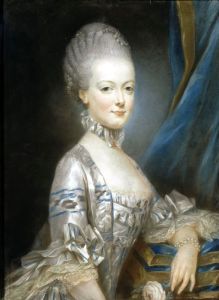‘The origins of white face make-up in Japanese culture is largely disputed. It has been said that in the middle ages, the white make-up originated when a Japanese traveler returned from Europe with stories of “pale faced” beauties. Whilst this sounds plausable, it is also been said that it originated from China and was adopted by the ladies of the Japanese court. Considering that the use of white make-up in Japanese history can be dated back as early as the Heian Era (794-1185 AD), a time when Japan was largely influence by the Chinese culture, this seems more likely the case.’
http://www.immortalgeisha.com/wiki/index.php?title=Main_Page
‘By 1500 B.C.E upper-class women in China and Japan used white rice powder on their faces, shaved and plucked their eyebrows, and painted their teeth gold and black.’
The Oxford Encyclopedia of Women in World History, p489 Edited by Bonnie G. Smith
‘Beginning in the 17th century and continuing throughout the 18th century, both men and women in England and France wore obvious cosmetics. Gender differences were less important than class differences – cosmetics marked one as aristocratic and à la mode, and were adopted as well by those who were trying to rise in social status or become fashionable. Makeup was not intended to look natural – in fact, it was called “paint” — but instead, “…to represent one’s aristocratic identity as declaratively as possible through cosmetic artifice” (Hyde). Women and men showed their respectability and class through white skin, and heavy makeup was considered more respectable than naturally light skin.

Marie Antoinette (Archduchess Maria Antonia of Austria) by Joseph Ducreux, 1769, Palace of Versailles, France
Cosmetics also had practical aims – their use created what was considered an attractive face, and they could hide the effects of age, blemishes, disease, or sun.’
http://demodecouture.com/hairstyles-cosmetics-18th-century/#hyde
Charles Hankinson (Eagle Tail), of the Canadian First Nations Mi’kmaq band, dances in full traditional regalia at the Healing Horse Spirit PowWow. His face paint was “gifted” to him by his grandfather:
http://stockarchive.photoshelter.com/image/I0000Zw9GywWf4wA
Mussiro is a thick white paste extracted from the roots of the ‘N’tunkuti’ tree, traditionally worn by Makua women of Mozambique and Tanzania.
Historically it was worn to signify virginity or to indicate menstruation or an absent husband or sexual availability. It was used in ceremonies to mark the beginning of womanhood or in funerals.
Mussiro is also valued as a beauty treatment and is used from the puberty onwards to protect the skin against acne and wrinkles:
